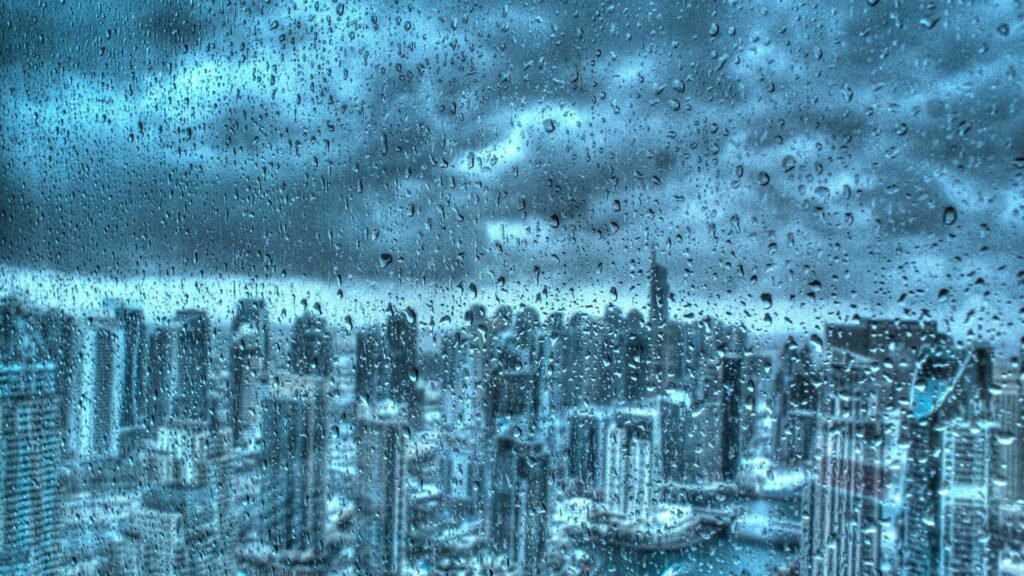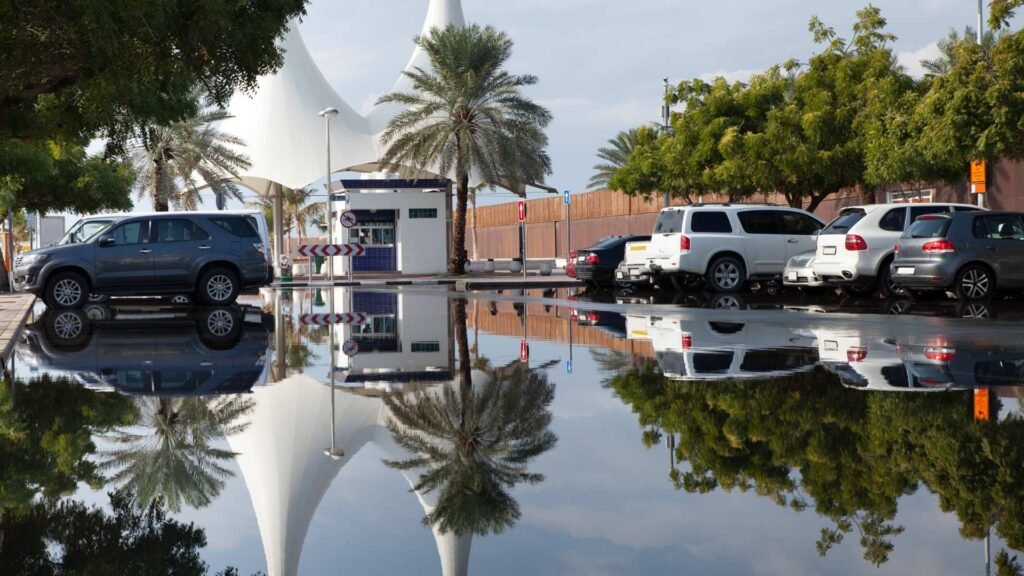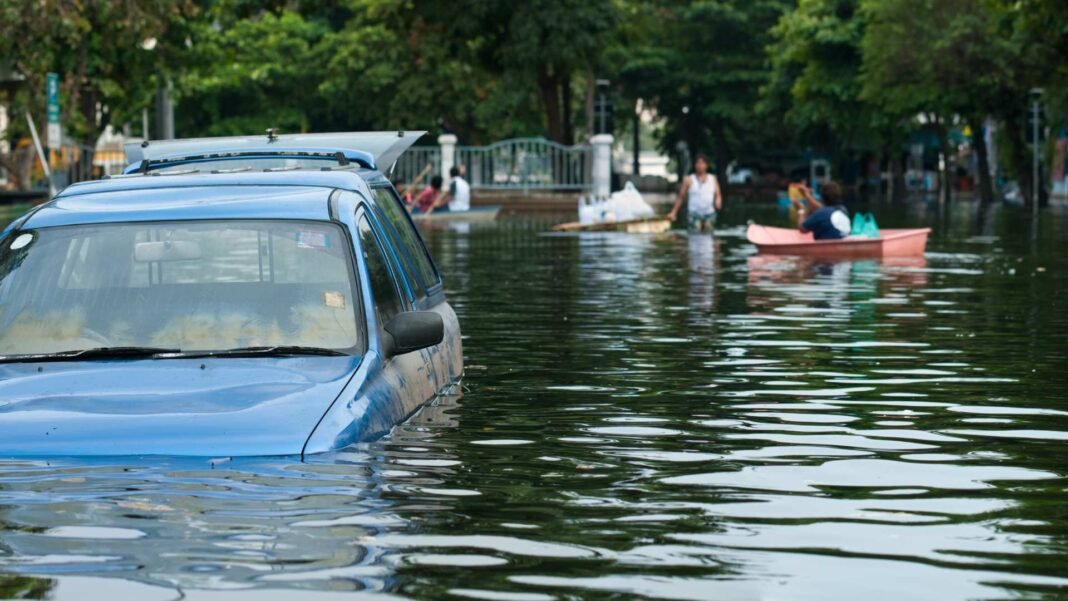Dubai, known for its scorching heat and arid climate, recently experienced an extraordinary weather event: torrential rains that flooded the city. The United Arab Emirates (UAE) faced its heaviest rainfall in 75 years, leaving highways submerged, malls inundated, and flights disrupted at one of the world’s busiest airports.
Recently, Dubai’s flood can be attributed to a combination of natural factors and human activities. While the region experiences occasional thunderstorms, the severity of Dubai’s floods raises questions about human-induced climate change and urbanization.
The Human Influence on Dubai’s Climate

Dubai’s rapid urbanization has drastically reshaped its landscape and environment. With the proliferation of skyscrapers, expansive highways, and vast concrete structures, the city has inadvertently created what is known as urban heat islands. These heat islands act as sponges, absorbing and trapping heat, thereby elevating temperatures within the city boundaries.
Moreover, the surge in greenhouse gas emissions stemming from various sources such as transportation, industrial activities, and energy production further compounds the city’s environmental challenges. These emissions contribute to local air pollution and exacerbate global climate change, impacting weather patterns on a broader scale.
In an attempt to address water scarcity issues, Dubai has ventured into innovative solutions such as cloud seeding. This technique involves the dispersal of certain chemicals into clouds to enhance rainfall. While proponents argue that cloud seeding could potentially alleviate water shortages, skeptics raise concerns about its potential to disrupt natural weather patterns.
Despite these efforts, experts caution against attributing the recent unprecedented rainfall solely to cloud seeding. While it may have a localized effect, other factors, including natural variability and broader climate change dynamics, play significant roles in shaping weather patterns.
Surviving in Dubai’s flood situation

As the rain relentlessly poured down, Dubai residents were caught off guard, finding themselves stranded in their cars and workplaces. What began as routine commutes quickly turned into arduous journeys, with some enduring 12-hour ordeals navigating flooded roads. At Dubai’s bustling airport, chaos ensued as passengers faced repeated flight delays, chaotic scenes, and a glaring lack of information. With uncertainty looming, some sought refuge in metro stations while others remained stranded at the airport, yearning for updates and clarity amidst the chaos.
Amidst the adversity, Dubai’s residents showcased remarkable resilience in the face of crisis. Despite the challenges, communities rallied together, sharing resources, offering assistance, and demonstrating solidarity. Amid the chaos, acts of kindness and support became beacons of hope, highlighting the strength of the human spirit in times of need. However, the events also served as a stark reminder of the importance of effective disaster management and communication.
The lack of preparedness underscored the need for improved disaster response mechanisms and clearer communication channels. While Dubai’s residents demonstrated commendable adaptability and solidarity, the chaotic scenes highlighted systemic gaps that must be addressed to enhance the city’s resilience in the face of future challenges.
Dubai’s Recovery Plan
In response to the disaster, the UAE government swiftly mobilized cleanup crews and emergency services. The unprecedented rainfall, described by the state-run WAM news agency as a “historic weather event,” highlighted the severity of the situation.
Looking ahead, Dubai is prioritizing infrastructure upgrades to prevent future flooding. Plans include investing in drainage systems, flood barriers, and urban planning improvements. The government also plans to review its cloud seeding program and explore sustainable alternatives, recognizing the need for proactive measures.
Dubai aims to enhance its resilience to extreme weather events by investing in infrastructure upgrades and reassessing strategies. Collaboration efforts between government agencies, private sector stakeholders, and the community will play a crucial role in achieving long-term resilience and ensuring the safety of residents.
Impact Assessment: Dubai’s Infrastructure, Environment, Economy, and Society
- Infrastructure Resilience and Upgrades:
- The disaster highlighted vulnerabilities in Dubai’s infrastructure. Long-term effects may include increased investments in flood prevention measures, such as improved drainage systems, flood barriers, and urban planning.
- The city may prioritize climate-resilient infrastructure to mitigate the impact of extreme weather events in the future.
- The floods likely caused damage to ecosystems, soil, and vegetation. Long-term effects may include changes in local biodiversity and habitat disruption.
- Soil erosion and sediment deposition could alter landscapes and affect agricultural productivity.
- Economic Repercussions:
- The disruption to flights, businesses, and daily life during the floods could have long-lasting economic consequences.
- Insurance claims, repair costs, and lost productivity may impact Dubai’s economy for months or even years.
- Health and public health preparedness:
- Dubai’s floods may have exposed gaps in emergency response and public health preparedness. Long-term effects could include improved disaster management protocols and better coordination among agencies.
- Waterborne diseases and health risks associated with flooding may also need ongoing attention.
5. Social resilience and community bonds:
- Dubai’s residents demonstrated resilience during the crisis. Long-term effects may include strengthened community bonds, increased awareness of disaster preparedness, and a sense of shared experience.
- The disaster could catalyze community-driven initiatives related to climate adaptation and resilience.
- Climate Adaptation Policies:
- The UAE government may reassess its climate adaptation policies. Long-term effects could include stricter regulations on construction, water management, and sustainable practices.
- Dubai may invest in climate research and data collection to better understand extreme weather patterns.
- Tourism and Perception:
- Dubai’s image as a luxurious and futuristic destination may be impacted. Long-term effects could include changes in tourism patterns as travelers consider climate-related risks.
- The city’s ability to recover swiftly and adapt to climate challenges will influence its global reputation.
The Road Ahead
Dubai has a history of rebounding from adversity. Its rapid development and innovation have made it a global hub. While Dubai’s floods were unprecedented, Dubai’s resilience and determination will likely drive its recovery.
Dubai may never be the same after this disaster. Dubai’s floods exposed vulnerabilities, prompting a reevaluation of its climate resilience. As the city rebuilds, it must balance progress with environmental sustainability.
While natural factors play a significant role in extreme weather events, human activities also contribute. Dubai’s response to the recent floods reflects both its challenges and its determination to adapt and thrive in a changing climate. As the desert city recovers, it faces an opportunity to build a more resilient and sustainable future.






